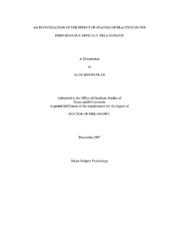| dc.contributor.advisor | Arthur, Winfred, Jr. | |
| dc.creator | Bhupatkar, Alok Ashutosh | |
| dc.date.accessioned | 2010-01-15T00:09:46Z | |
| dc.date.accessioned | 2010-01-16T00:43:17Z | |
| dc.date.available | 2010-01-15T00:09:46Z | |
| dc.date.available | 2010-01-16T00:43:17Z | |
| dc.date.created | 2007-12 | |
| dc.date.issued | 2009-05-15 | |
| dc.identifier.uri | https://hdl.handle.net/1969.1/ETD-TAMU-2589 | |
| dc.description.abstract | The objective of the current study was to investigate the relationship between
training performance and self–efficacy using a longitudinal design (approximately 11
weeks) in the context of massed and distributed practice. Limited attention in the
training performance and efficacy literature has been paid to the spacing of practice
(massed and distributed). However, it is conceivable that both the spacing of practice as
well as the time frames over which it operates could influence the performance and
efficacy relationship. Based on the practice schedule (massed versus distributed) and
longitudinal study design, it was posited that the nature of the performance and efficacy
relationship is likely to be quite different during two phases of learning (acquisition and
reacquisition). Data were obtained from 198 undergraduate students over an 11–week
training protocol using a 2 (distributed versus massed acquisition) × 2 (distributed versus
massed reacquisition) × 16 (session) mixed design. Contrary to the first set of
hypotheses, results indicated that the performance and efficacy relationship did not vary
as a function of practice protocols (massed versus distributed) during acquisition and reacquisition. Also, no support was found for the hypothesis that the performance and
efficacy relationship will vary as a function of whether the practice condition during
acquisition is the same or different from the practice condition during reacquisition such
that the relationships will be stronger when the practice condition is the same as opposed
to when it is different. However, support was found for the hypothesis that when past
performance is controlled the unique contribution of self–efficacy to subsequent task
performance will be attenuated. Implications of these findings for research on the
performance and efficacy relationship and training practice are discussed. | en |
| dc.format.medium | electronic | en |
| dc.format.mimetype | application/pdf | |
| dc.language.iso | en_US | |
| dc.subject | Performance | en |
| dc.subject | Efficacy | en |
| dc.title | An investigation of the effect of spacing of practice on the performance-efficacy relationship | en |
| dc.type | Book | en |
| dc.type | Thesis | en |
| thesis.degree.department | Psychology | en |
| thesis.degree.discipline | Psychology | en |
| thesis.degree.grantor | Texas A&M University | en |
| thesis.degree.name | Doctor of Philosophy | en |
| thesis.degree.level | Doctoral | en |
| dc.contributor.committeeMember | Bergman, Mindy | |
| dc.contributor.committeeMember | Payne, Stephanie | |
| dc.contributor.committeeMember | Porter, Christopher | |
| dc.type.genre | Electronic Dissertation | en |
| dc.type.material | text | en |
| dc.format.digitalOrigin | born digital | en |


